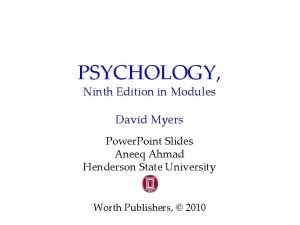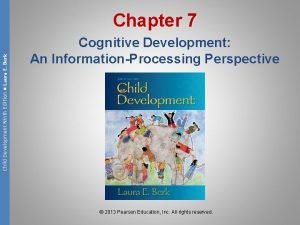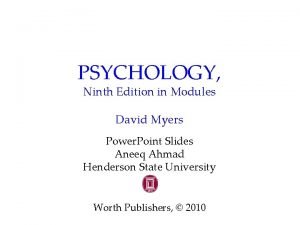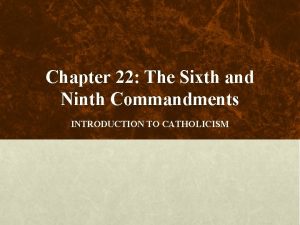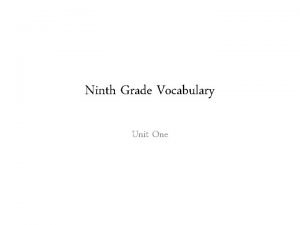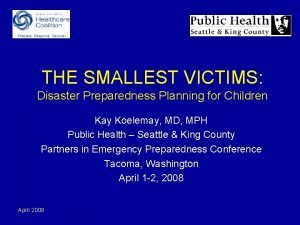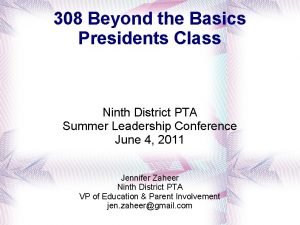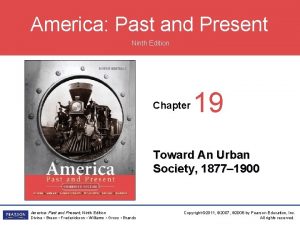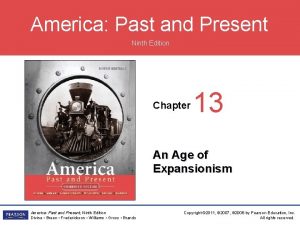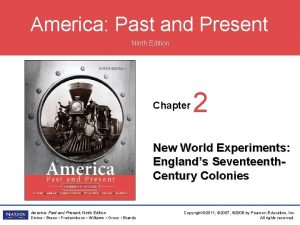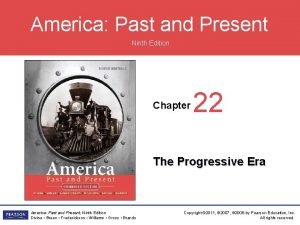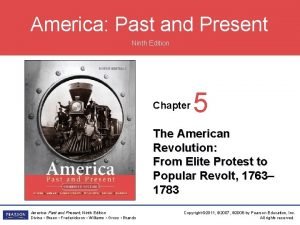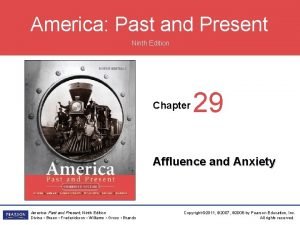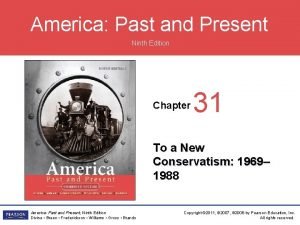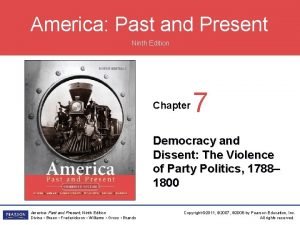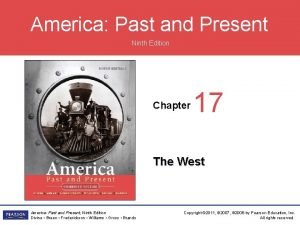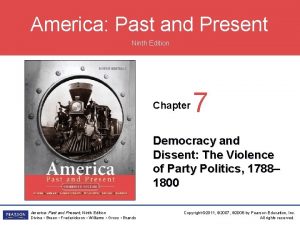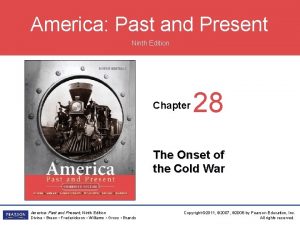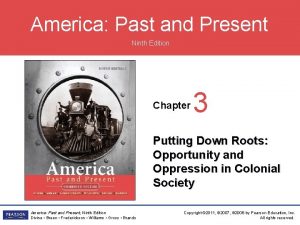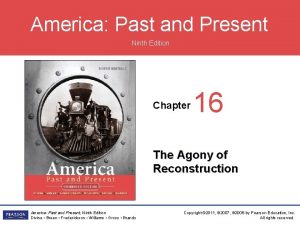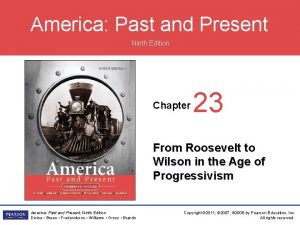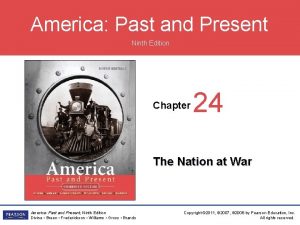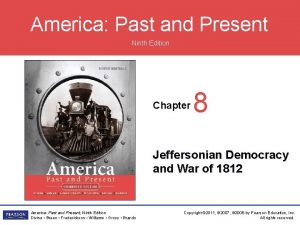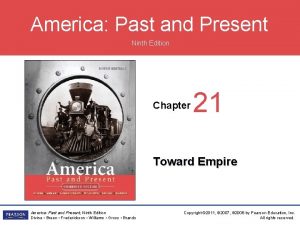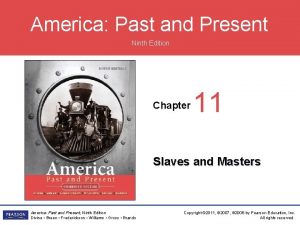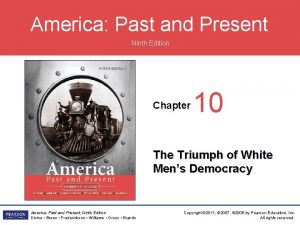America Past and Present Ninth Edition Chapter 18





































- Slides: 37

America: Past and Present Ninth Edition Chapter 18 The Industrial Society America: Past and Present, Ninth Edition Divine • Breen • Frederickson • Williams • Gross • Brands Copyright © 2011, © 2007, © 2006 by Pearson Education, Inc. All rights reserved.

Industrial Development • Late nineteenth-century concentrated in Northeast - rapid industrial growth • Abundance of cheap natural resources • Large pools of labor – immigrants • Largest free trade market in the world • Capital, no government regulation • New technological innovations • Rapid growth 1865– 1914 America: Past and Present, Ninth Edition Divine • Breen • Frederickson • Williams • Gross • Brands Copyright © 2011, © 2007, © 2006 by Pearson Education, Inc. All rights reserved.

An Empire on Rails • U. S. industrial economy based on expansion of the railroads • Railroads led to integrated national economic system • Railroads most significant technical innovation • Steamships made Atlantic crossings twice as fast America: Past and Present, Ninth Edition Divine • Breen • Frederickson • Williams • Gross • Brands Copyright © 2011, © 2007, © 2006 by Pearson Education, Inc. All rights reserved.

“Emblem of Motion and Power” • Railroads transform American life – – – End rural isolation Allow regional economic specialization Make mass production, consumption possible Lead to organization of modern corporation Stimulate other industries • Railroads – America’s “first big business” capture the imagination of the American people America: Past and Present, Ninth Edition Divine • Breen • Frederickson • Williams • Gross • Brands Copyright © 2011, © 2007, © 2006 by Pearson Education, Inc. All rights reserved.

Building the Empire • 1865– 1916: U. S. lays over 200, 000 miles • Made possible because expenses met by governments at all levels • Federal railroad grants prompt corruption • 1850– 1945: Railroads save government $1 billion in freight costs America: Past and Present, Ninth Edition Divine • Breen • Frederickson • Williams • Gross • Brands Copyright © 2011, © 2007, © 2006 by Pearson Education, Inc. All rights reserved.

Federal Land Grants to Railroads as of 1871 America: Past and Present, Ninth Edition Divine • Breen • Frederickson • Williams • Gross • Brands Copyright © 2011, © 2007, © 2006 by Pearson Education, Inc. All rights reserved.

Railroad Construction, 1830– 1920 America: Past and Present, Ninth Edition Divine • Breen • Frederickson • Williams • Gross • Brands Copyright © 2011, © 2007, © 2006 by Pearson Education, Inc. All rights reserved.

Linking the Nation via Trunk Lines • No integrated rail system before Civil War – different schedules and incompatible gauges • After 1860 construction and consolidation of trunk lines proceed rapidly • “Commodore” Cornelius Vanderbilt – big name in railroads • Rail transportation becomes safe, fast, reliable America: Past and Present, Ninth Edition Divine • Breen • Frederickson • Williams • Gross • Brands Copyright © 2011, © 2007, © 2006 by Pearson Education, Inc. All rights reserved.

Rails Across the Continent • 1862: Congress authorizes the transcontinental railroad • Union Pacific works westward from Nebraska using Irish laborers • Central Pacific works eastward using Chinese immigrants • May 10, 1869: Tracks meet in Promontory, Utah • By 1900, four more lines to Pacific America: Past and Present, Ninth Edition Divine • Breen • Frederickson • Williams • Gross • Brands Copyright © 2011, © 2007, © 2006 by Pearson Education, Inc. All rights reserved.

Transcontinental Railroad America: Past and Present, Ninth Edition Divine • Breen • Frederickson • Williams • Gross • Brands Copyright © 2011, © 2007, © 2006 by Pearson Education, Inc. All rights reserved.

Railroads, 1870 and 1890 America: Past and Present, Ninth Edition Divine • Breen • Frederickson • Williams • Gross • Brands Copyright © 2011, © 2007, © 2006 by Pearson Education, Inc. All rights reserved.

Problems of Growth • Intense competition among railroads and overexpansion • Efforts to share freight in an orderly way fail • After Panic of 1893, bankers gain control of railroad corporations • Bankers like J. P. Morgan impose order by consolidating to eliminate competition, increase efficiency – Morgan most important in finance • In 1900, seven giant rail systems dominate America: Past and Present, Ninth Edition Divine • Breen • Frederickson • Williams • Gross • Brands Copyright © 2011, © 2007, © 2006 by Pearson Education, Inc. All rights reserved.

J. Pierpont Morgan • Finance • First Billion Dollar Co • U. S. Steel America: Past and Present, Ninth Edition Divine • Breen • Frederickson • Williams • Gross • Brands Copyright © 2011, © 2007, © 2006 by Pearson Education, Inc. All rights reserved.

An Industrial Empire • Bessemer process of refining steel permits mass production (William Kelly) • Use of steel changes agriculture, manufacturing, transportation, architecture America: Past and Present, Ninth Edition Divine • Breen • Frederickson • Williams • Gross • Brands Copyright © 2011, © 2007, © 2006 by Pearson Education, Inc. All rights reserved.

Andrew Carnegie • Immigrant • Steel America: Past and Present, Ninth Edition Divine • Breen • Frederickson • Williams • Gross • Brands Copyright © 2011, © 2007, © 2006 by Pearson Education, Inc. All rights reserved.

Carnegie and Steel • 1872: Andrew Carnegie enters steel business – organizes steel industry • By 1901, Carnegie employs 20, 000 and produces more steel than Great Britain • Sells out to J. P. Morgan • Morgan heads incorporation of the United States Steel Company – first billion-dollar company America: Past and Present, Ninth Edition Divine • Breen • Frederickson • Williams • Gross • Brands Copyright © 2011, © 2007, © 2006 by Pearson Education, Inc. All rights reserved.

International Steel Production, 1880– 1914 America: Past and Present, Ninth Edition Divine • Breen • Frederickson • Williams • Gross • Brands Copyright © 2011, © 2007, © 2006 by Pearson Education, Inc. All rights reserved.

Rockefeller and Oil • Petroleum profitable as kerosene for lighting • 1859: First oil well drilled in Pennsylvania • 1863: John D. Rockefeller organizes Standard Oil Company of Ohio America: Past and Present, Ninth Edition Divine • Breen • Frederickson • Williams • Gross • Brands Copyright © 2011, © 2007, © 2006 by Pearson Education, Inc. All rights reserved.

John D. Rockefeller • Oil • Standard Oil America: Past and Present, Ninth Edition Divine • Breen • Frederickson • Williams • Gross • Brands Copyright © 2011, © 2007, © 2006 by Pearson Education, Inc. All rights reserved.

Rockefeller and Oil • Rockefeller lowers costs, improves quality, establishes efficient marketing operation • Rockefeller consolidation, not competition, creates stronger companies • Standard Oil is first modern trust/monopoly • Standard Oil Trust centralizes Rockefeller’s control of oil companies • Other industries follow and form trusts • Iron Law of Wages – all captains of industry • Vertical integration America: Past and Present, Ninth Edition Divine • Breen • Frederickson • Williams • Gross • Brands Copyright © 2011, © 2007, © 2006 by Pearson Education, Inc. All rights reserved.

Business Terms • Vertical integration – definition: A type of organization in which a single company owns and controls the entire process from obtaining raw materials to manufacture and sale of the finished product • Iron law of wages – supply and demand, NOT the welfare of workers dictated wages America: Past and Present, Ninth Edition Divine • Breen • Frederickson • Williams • Gross • Brands Copyright © 2011, © 2007, © 2006 by Pearson Education, Inc. All rights reserved.

The Business of Invention • Late nineteenth-century industry leads to new American technology • Radically changes American life • An Age of Invention – Telegraph, camera, processed foods, telephone, phonograph, incandescent lamp • Electricity in growing use by 1900 - Edison • Telephone and electricity most important inventions America: Past and Present, Ninth Edition Divine • Breen • Frederickson • Williams • Gross • Brands Copyright © 2011, © 2007, © 2006 by Pearson Education, Inc. All rights reserved.

Patents Issued, by Decade, 1850– 1899 America: Past and Present, Ninth Edition Divine • Breen • Frederickson • Williams • Gross • Brands Copyright © 2011, © 2007, © 2006 by Pearson Education, Inc. All rights reserved.

The Sellers • Marketing and advertising become common • New ways of selling include chain store, department store, brand name, mail-order, example, Marshall Fields Department – 8 story building • Provides convenience and standardization to buyers • Americans become a community of consumers America: Past and Present, Ninth Edition Divine • Breen • Frederickson • Williams • Gross • Brands Copyright © 2011, © 2007, © 2006 by Pearson Education, Inc. All rights reserved.

The Wage Earners • The labor of millions of men and women built the new industrial society – mainly immigrants • Low wages/long hours/unskilled jobs • Old work practices not applicable • Work is impersonal/routine/supervised • No job stability – mobile work force • Child labor America: Past and Present, Ninth Edition Divine • Breen • Frederickson • Williams • Gross • Brands Copyright © 2011, © 2007, © 2006 by Pearson Education, Inc. All rights reserved.

Working Men, Working Women, Working Children • Chronically low wages – Average wages: $400– 500 per year – Salary required for decent living: $600 per year • Dangerous working conditions – Railroad injury rate: 1 in 26, death rate 1 in 399 – Factory workers suffer chronic illness from pollutants America: Past and Present, Ninth Edition Divine • Breen • Frederickson • Williams • Gross • Brands Copyright © 2011, © 2007, © 2006 by Pearson Education, Inc. All rights reserved.

Working Men, Working Women, Working Children • Composition of the labor force by 1900: – 20% women – Women represented in 296 of 303 occupations – 10% of girls employed, 20% of boys • Working children – “Child labor” means under 14 – All children poorly paid – Girls receive much lower wage than boys America: Past and Present, Ninth Edition Divine • Breen • Frederickson • Williams • Gross • Brands Copyright © 2011, © 2007, © 2006 by Pearson Education, Inc. All rights reserved.

Working Men, Working Women, Working Children • Working women’s characteristics: – Most young and single – 25% of married African American women work in 1900 • Working women’s jobs – Many move into clerical positions or other traditional female jobs – A few occupy professional positions • Working women’s earnings unequal to men’s America: Past and Present, Ninth Edition Divine • Breen • Frederickson • Williams • Gross • Brands Copyright © 2011, © 2007, © 2006 by Pearson Education, Inc. All rights reserved.

Working Men, Working Women, Working Children • Discriminatory wage structure – Adults earn more than children – Men earn nearly twice as much as women – Whites earn more than blacks or Asians – Protestants earn more than Catholics or Jews – Black workers earn less at every level and skill America: Past and Present, Ninth Edition Divine • Breen • Frederickson • Williams • Gross • Brands Copyright © 2011, © 2007, © 2006 by Pearson Education, Inc. All rights reserved.

Working Men, Working Women, Working Children • Chinese suffer periodic discrimination – 1879: California constitution forbids corporations to hire Chinese – 1882: Federal Chinese Exclusion Act prohibits Chinese immigration for 10 years America: Past and Present, Ninth Edition Divine • Breen • Frederickson • Williams • Gross • Brands Copyright © 2011, © 2007, © 2006 by Pearson Education, Inc. All rights reserved.

Culture of Work • Factory work habits demand adjustments for immigrants, rural folk • Many adjust well enough to advance • Many more see children advance to better jobs America: Past and Present, Ninth Edition Divine • Breen • Frederickson • Williams • Gross • Brands Copyright © 2011, © 2007, © 2006 by Pearson Education, Inc. All rights reserved.

Labor Unions • Early labor unions like fraternal orders – Knights of Labor fails – poor leadership • 1886: Samuel Gompers founds American Federation of Labor • A. F. L. seeks practical improvements • Higher wages, better working conditions – – Focus on skilled workers Ignores women, African Americans America: Past and Present, Ninth Edition Divine • Breen • Frederickson • Williams • Gross • Brands Copyright © 2011, © 2007, © 2006 by Pearson Education, Inc. All rights reserved.

Labor Unrest • Crossed purposes – – Employees seek to humanize the factory Employers try to apply strict laws of the market • Courts come down on side of owners with injunctions against strikes America: Past and Present, Ninth Edition Divine • Breen • Frederickson • Williams • Gross • Brands Copyright © 2011, © 2007, © 2006 by Pearson Education, Inc. All rights reserved.

Labor Unrest • An era of strikes – – 1877: Rail strikes nearly shut down system, over 100 workers killed in suppressing it 1880– 1900: 23, 000 strikes • 1886: Chicago Haymarket incident prompts fears of anarchist uprising • Incident weakens national labor movement America: Past and Present, Ninth Edition Divine • Breen • Frederickson • Williams • Gross • Brands Copyright © 2011, © 2007, © 2006 by Pearson Education, Inc. All rights reserved.

Labor Unrest • 1892: Homestead steel strike – emphasized the cost of industrialization – Pinkerton detectives as strike-breaking army – Pinkertons in gun battle with strikers – State militia called in to restore order – Attempted assassination of Carnegie partner Henry Clay Frick America: Past and Present, Ninth Edition Divine • Breen • Frederickson • Williams • Gross • Brands Copyright © 2011, © 2007, © 2006 by Pearson Education, Inc. All rights reserved.

Labor Strikes, 1870– 1890 America: Past and Present, Ninth Edition Divine • Breen • Frederickson • Williams • Gross • Brands Copyright © 2011, © 2007, © 2006 by Pearson Education, Inc. All rights reserved.

Industrialization’s Benefits and Costs • Benefits of rapid industrialization – – Rise in national power and wealth Improving standard of living • Negative human cost of industrialization – – Exploitation Social unrest Growing disparity between rich and poor Increasing power of giant corporations America: Past and Present, Ninth Edition Divine • Breen • Frederickson • Williams • Gross • Brands Copyright © 2011, © 2007, © 2006 by Pearson Education, Inc. All rights reserved.
 Anatomy and physiology ninth edition
Anatomy and physiology ninth edition Psychology ninth edition in modules
Psychology ninth edition in modules Macroeconomics mankiw 9th edition
Macroeconomics mankiw 9th edition Psychology ninth edition david g myers
Psychology ninth edition david g myers Social psychology ninth edition
Social psychology ninth edition Biology ninth edition
Biology ninth edition Laura e berk child development (9th edition pdf)
Laura e berk child development (9th edition pdf) Berk 2013 child development
Berk 2013 child development Lysanx
Lysanx Psychology ninth edition in modules
Psychology ninth edition in modules Psychology ninth edition in modules
Psychology ninth edition in modules Biology ninth edition
Biology ninth edition Campbell ninth edition
Campbell ninth edition Past simple past continuous past perfect present perfect
Past simple past continuous past perfect present perfect Sixth commandment catholic
Sixth commandment catholic The sixth and ninth commandments
The sixth and ninth commandments Past continuous y past simple
Past continuous y past simple Past simple past continuous present perfect
Past simple past continuous present perfect Greek root light
Greek root light What is ramadon
What is ramadon William blount ninth grade academy
William blount ninth grade academy Lower ninth ward
Lower ninth ward 12 course french classical menu ppt
12 course french classical menu ppt Ninth district pta
Ninth district pta Mis chapter 6
Mis chapter 6 Chapter 1
Chapter 1 The american system of criminal justice 16th edition
The american system of criminal justice 16th edition Past simple past perfect past continuous exercises
Past simple past perfect past continuous exercises Rap of the map of the us
Rap of the map of the us Your name
Your name Whats an onomatopeia
Whats an onomatopeia Why is latin america called latin america
Why is latin america called latin america Eu amo a américa e a américa me ama
Eu amo a américa e a américa me ama Present form of the verb examples
Present form of the verb examples Present participle of drink
Present participle of drink Simple past and past progressive
Simple past and past progressive Present perfet
Present perfet Present perfect simple present perfect progressive
Present perfect simple present perfect progressive




